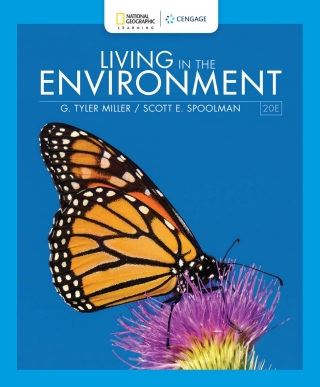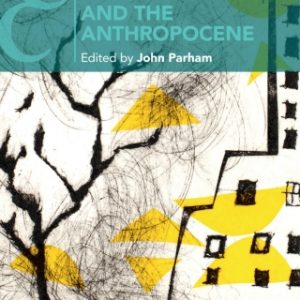Buy Living in the Environment, 20th Edition PDF ebook by author G. Tyler Miller; Scott Spoolman – published by Cengage Learning in 2021 and save up to 80% compared to the print version of this textbook. With PDF version of this textbook, not only save you money, you can also highlight, add text, underline add post-it notes, bookmarks to pages, instantly search for the major terms or chapter titles, etc.
You can search our site for other versions of the Living in the Environment, 20th Edition PDF ebook. You can also search for others PDF ebooks from publisher Cengage Learning, as well as from your favorite authors. We have thousands of online textbooks and course materials (mostly in PDF) that you can download immediately after purchase.
Note: e-textBooks do not come with access codes, CDs/DVDs, workbooks, and other supplemental items.
eBook Details:
Full title: Living in the Environment, 20th Edition
Edition: 20th
Copyright year: 2021
Publisher: Cengage Learning
Author: G. Tyler Miller; Scott Spoolman
ISBN: 978-0357142202, 978-0357142332
Format: PDF
Description of Living in the Environment, 20th Edition:
Featuring captivating photos and illustrations from National Geographic, Miller/Spoolman’s LIVING IN THE ENVIRONMENT, 20th edition, empowers you with the knowledge and inspiration to make a difference in solving today’s environmental issues. Emphasizing sustainability, the book presents clear introductions to multiple environmental problems along with balanced evaluations of potential solutions. Up-to-date coverage includes no-till farming, proposed changes to the Endangered Species Act, CRISPR gene editing, the phosphate crisis, genetically engineered foods, lithium supplies for batteries, threats to U.S. recycling, the use of economics to slow climate change and more. A focus on learning from nature highlights principles and applications of biomimicry. Exercises throughout sharpen your critical-thinking skills, while Core Case Studies give you practice applying what you’ve learned.Important Notice: Media content referenced within the product description or the product text may not be available in the ebook version.
Table of Contents of Living in the Environment, 20th Edition PDF ebook:
Brief ContentsContentsPrefaceLearning SkillsAbout the AuthorsFrom the AuthorsUnit 1: Humans and Sustainability: An OverviewChapter 1: The Environment and Sustainability1.1 Principles of Sustainability1.2 Human Impacts on the Earth1.3 Causes of Environmental Problems1.4 Environmentally Sustainable SocietiesCritical ThinkingDoing Environmental ScienceEcological Footprint AnalysisUnit 2: Science, Ecological Principles, and SustainabilityChapter 2: Science, Matter, Energy, and Systems2.1 Science2.2 Matter and Changes in Matter2.3 Energy and Changes in Energy2.4 Systems and How They Respond to ChangeCritical ThinkingDoing Environmental ScienceData AnalysisChapter 3: Ecosystems: What Are They and How Do They Work?3.1 Earth’s Life-Support System3.2 Ecosystem Components3.3 Energy in an Ecosystem3.4 Matter in an Ecosystem3.5 How Do Scientists Study Ecosystems?Critical ThinkingDoing Environmental ScienceData AnalysisChapter 4: Biodiversity and Evolution4.1 Earth’s Life4.2 Importance of Biodiversity4.3 Roles of Species in Ecosystems4.4 Evolution4.5 Factors Affecting BiodiversityCritical ThinkingDoing Environmental ScienceData AnalysisChapter 5: Species Interactions, Ecological Succession, and Population Control5.1 Species Interactions5.2 Ecological Succession5.3 Limits to Population GrowthCritical ThinkingDoing Environmental ScienceData AnalysisChapter 6: The Human Population6.1 How Many People Can the Earth Support?6.2 Factors Affecting Human Population Size6.3 Age Structure and Population Growth6.4 Slowing Human Population GrowthCritical ThinkingDoing Environmental ScienceData AnalysisChapter 7: Climate and Terrestrial Biodiversity7.1 Weather7.2 Climate7.3 Climate and BiomesDoing Environmental ScienceData AnalysisChapter 8: Aquatic Biodiversity8.1 Aquatic Systems8.2 Importance of Marine Aquatic Systems8.3 Effects of Human Activities on Marine Ecosystems8.4 Importance of Freshwater Ecosystems8.5 Effects of Human Activities on Freshwater EcosystemsCritical ThinkingDoing Environmental ScienceData AnalysisUnit 3: Sustaining BiodiversityChapter 9: Sustaining Biodiversity: Saving Species and Ecosystem Services9.1 Species Extinction9.2 Why Should We Care about Species Extinction?9.3 Humans and Species Extinction9.4 Sustaining Wild Species and Ecosystem ServicesDoing Environmental ScienceData AnalysisChapter 10: Sustaining Biodiversity: Saving Ecosystems and Ecosystem Services10.1 Threats to Forest Ecosystems10.2 Managing and Sustaining Forests10.3 Managing and Sustaining Grasslands10.4 Sustaining Terrestrial Biodiversity and Ecosystem ServicesCritical ThinkingDoing Environmental ScienceEcological Footprint AnalysisChapter 11: Sustaining Aquatic Biodiversity and Ecosystem Services11.1 Threats to Aquatic Biodiversity11.2 Protecting and Sustaining Marine Biodiversity11.3 Managing and Sustaining Marine Fisheries11.4 Protecting and Sustaining Wetlands11.5 Protecting and Sustaining Freshwater Lakes, Rivers, and Fisheries11.6 Priorities for Sustaining Aquatic BiodiversityCritical ThinkingDoing Environmental ScienceEcological Footprint AnalysisUnit 4: Sustaining Natural ResourcesChapter 12: Food Production and the Environment12.1 Food Security12.2 Food Production12.3 Environmental Effects of Food Production12.4 Protecting Crops from Pests12.5 Producing Food More Sustainably12.6 Improving Food SecurityCritical ThinkingDoing Environmental ScienceEcological Footprint AnalysisChapter 13: Water Resources13.1 Earth’s Water Resources13.2 Sustainability of Groundwater13.3 Increasing Freshwater Supplies13.4 Water Transfers13.5 Using Freshwater More Sustainably13.6 FloodingCritical ThinkingDoing Environmental ScienceEcological Footprint AnalysisChapter 14: Geology and Mineral Resources14.1 Geology and Mineral Resources14.2 Supplies of Nonrenewable Mineral Resources14.3 Environmental Effects of Using Nonrenewable Mineral Resources14.4 Using Mineral Resources More Sustainably14.5 Geological HazardsCritical ThinkingDoing Environmental ScienceData AnalysisChapter 15: Nonrenewable Energy15.1 Energy Resources15.2 Oil15.3 Natural Gas15.4 Coal15.5 Nuclear PowerCritical ThinkingDoing Environmental ScienceData AnalysisChapter 16: Energy Efficiency and Renewable Energy16.1 A New Energy Transition16.2 Reducing Energy Waste16.3 Solar Energy16.4 Wind Energy16.5 Geothermal Energy16.6 Biomass Energy16.7 Hydropower16.8 Hydrogen16.9 A More Sustainable Energy FutureCritical ThinkingDoing Environmental ScienceData AnalysisUnit 5: Sustaining Environmental QualityChapter 17: Environmental Hazards and Human Health17.1 Health Hazards and Risk Assessment17.2 Biological Hazards17.3 Chemical Hazards17.4 Evaluating Risks from Chemical Hazards17.5 Perceiving and Avoiding RisksCritical ThinkingDoing Environmental ScienceData AnalysisChapter 18: Air Pollution and Ozone Depletion18.1 The Atmosphere18.2 Outdoor Air Pollution18.3 Acid Deposition18.4 Indoor Air Pollution18.5 Health Effects of Air Pollution18.6 Reducing Air Pollution18.7 Ozone Layer DepletionCritical ThinkingDoing Environmental ScienceData AnalysisChapter 19: Climate Change19.1 Climate Change19.2 Causes of Climate Change19.3 Effects of Climate Change19.4 Slowing Climate Change19.5 Adapting to Climate ChangeCritical ThinkingDoing Environmental ScienceEcological Footprint AnalysisChapter 20: Water Pollution20.1 Water Pollution: Causes and Effects20.2 Stream and Lake Pollution20.3 Groundwater Pollution20.4 Ocean Pollution20.5 Water Pollution SolutionsCritical ThinkingDoing Environmental ScienceData AnalysisChapter 21: Solid and Hazardous Waste21.1 Solid and Hazardous Waste Problems21.2 Dealing with Solid Waste21.3 Reducing Solid Waste21.4 Burning or Burying Solid Waste21.5 Dealing with Hazardous Waste21.6 A Low-Waste EconomyCritical ThinkingDoing Environmental ScienceEcological Footprint AnalysisChapter 22: Urbanization and Sustainability22.1 Urbanization22.2 Resource and Environmental Problems22.3 Transportation22.4 Land-Use Planning22.5 Urban SustainabilityCritical ThinkingDoing Environmental ScienceEcological Footprint AnalysisUnit 6: Sustaining Human SocietiesChapter 23: Economics, Environment, and Sustainability23.1 Economic Systems and the Biosphere23.2 Economic Value of Natural Capital and Pollution Control23.3 Using Economics to Deal with Environmental Problems23.4 Poverty and Environmental Problems23.5 Environmentally Sustainable EconomiesCritical ThinkingDoing Environmental ScienceData AnalysisChapter 24: Politics, Environment, and Sustainability24.1 Government Role in a Transition to Sustainable Societies24.2 Environmental Policy24.3 Environmental Laws24.4 Environmental Groups24.5 Environmental Security24.6 Sustainable and Just Environmental PoliciesCritical ThinkingDoing Environmental ScienceData AnalysisChapter 25: Environmental Worldviews, Ethics, and Sustainability25.1 Environmental Worldviews25.2 Role of Education25.3 Living More SustainablyCritical ThinkingDoing Environmental ScienceEcological Footprint AnalysisGlossaryIndex





